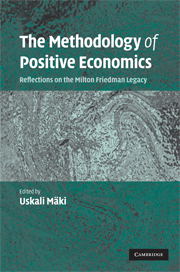Book contents
- Frontmatter
- Contents
- List of figures
- List of tables
- Contributors
- Preface
- Part 1 The classical essay in twentieth-century economic methodology
- Part 2 Reading and writing a classic
- Part 3 Models, assumptions, predictions, evidence
- Part 4 Theoretical context: firm, money, expected utility, Walras and Marshall
- 8 Friedman's 1953 essay and the marginalist controversy
- 9 Friedman (1953) and the theory of the firm
- 10 Friedman's selection argument revisited
- 11 Expected utility and Friedman's risky methodology
- 12 Milton Friedman's stance: the methodology of causal realism
- 13 On the right side for the wrong reason: Friedman on the Marshall–Walras divide
- Part 5 Concluding perspectives
- Index
9 - Friedman (1953) and the theory of the firm
Published online by Cambridge University Press: 02 December 2009
- Frontmatter
- Contents
- List of figures
- List of tables
- Contributors
- Preface
- Part 1 The classical essay in twentieth-century economic methodology
- Part 2 Reading and writing a classic
- Part 3 Models, assumptions, predictions, evidence
- Part 4 Theoretical context: firm, money, expected utility, Walras and Marshall
- 8 Friedman's 1953 essay and the marginalist controversy
- 9 Friedman (1953) and the theory of the firm
- 10 Friedman's selection argument revisited
- 11 Expected utility and Friedman's risky methodology
- 12 Milton Friedman's stance: the methodology of causal realism
- 13 On the right side for the wrong reason: Friedman on the Marshall–Walras divide
- Part 5 Concluding perspectives
- Index
Summary
Inasmuch as “all theories, not just the neoclassical, start with the existence of firms” (Arrow 1999, vi), since the theory of the firm figures prominently in both Milton Friedman's essay on “The methodology of positive economics” (F53) and my own research agenda, and since we are all closet methodologists, I responded with alacrity to the invitation to prepare a paper on F53 as it relates to the theory of the firm. My remarks are organized in four parts.
I begin with what I take to be the main message of the essay: most economists are and should be engaged in the study of positive economics. What I regard as overreaching parts of the essay are discussed in section 2. Post-1953 developments in the theory of the firm are sketched in section 3. Concluding remarks follow.
The main message
The first ten pages of the F53 contain the main message. Specifically, the task of positive economics “is to provide a system of generalizations that can be used to make correct predictions about the consequences of any change in circumstances. Its performance is to be judged by the precision, scope, and conformity with experience of the predictions it yields” (F53, 4). Additionally, simplicity and fruitfulness are important criteria in evaluating alternative theories (F53, 10). As Friedman subsequently remarks, “Most phenomena are driven by a very few central forces. What a good theory does is to simplify, it pulls out the central forces and gets rid of the rest” (Snowdon and Vane 1997, 196).
- Type
- Chapter
- Information
- The Methodology of Positive EconomicsReflections on the Milton Friedman Legacy, pp. 241 - 256Publisher: Cambridge University PressPrint publication year: 2009
- 3
- Cited by

